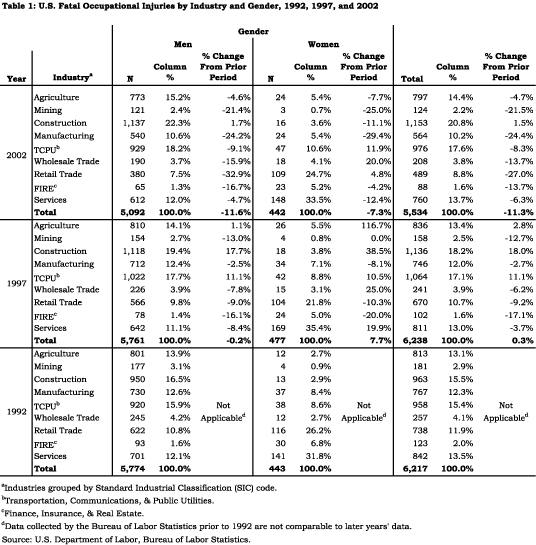
© Copyright 2005 by the Wyoming Department of Employment, Research & Planning
WYOMING LABOR FORCE TRENDS
Vol. 42 No. 3
Occupational Fatalities in the U.S.
by: Sara Saulcy, Senior Economist
More than 5,000 people die annually on the job. Men represent more than 90 percent of all on-the-job fatalities. The industry in which the largest number of deaths occurred was Construction. Traffic accidents are the most common cause of work-related death, followed by assaults & violent acts. From 1992 to 2002, workplace deaths caused by traffic accidents and assaults & violent acts declined.
Work-related injuries in the United States claim the lives of more than 5,000 individuals annually. Men are most frequently on-the-job fatality victims. This article explores gender variations in fatalities based on two criteria: the industry in which the fatality occurred and the event or exposure that caused the fatality.
Data
Because relatively few work-related deaths occur in Wyoming (33 in 2002), occupation-specific data is unavailable at the state level. Therefore, we use national data from the U.S. Department of Labor, Bureau of Labor Statistics (BLS). The data are from the Census of Fatal Occupational Injuries (CFOI) program, a joint federal-state venture. The data are from three time periods: 1992, 1997, and 2002. Data from other years are available on the Injuries, Illnesses, and Fatalities home page at
http://www.bls.gov/iif/home.htm
Gender Variation by Industry
Table 1 illustrates work-related fatalities within Standard Industrial Classification (SIC) industry (excluding government) for 1992, 1997, and 2002. In 1992, a total of 6,217 fatalities occurred. Of those, 5,774 were men (92.9%). A total of 6,238 deaths occurred in 1997, an increase of 0.3 percent from 1992. Women accounted for 477 (7.6%) of those deaths. From 1992 to 1997, work-related fatalities involving men declined by 0.2 percent, while those involving women increased 7.7 percent. A total of 5,534 individuals died on the job in 2002, a decline of 11.3 percent from 1997. Of those, 92.0 percent (5,092) of the fatalities were men. From 1997 to 2002, there was a decline in fatalities of 11.6 percent for men, while women experienced a decline of 7.3 percent.
For each of the three years examined in this article, the Construction industry consistently had the most fatalities. Construction was the main industry in which men died, with 16.5 percent of deaths in 1992, 19.4 percent in 1997, and 22.3 percent in 2002. In contrast to men, the industry in which the most women died was Services. The Services industry had 31.8 percent of womenís work-related fatalities in 1992, 35.4 percent in 1997, and 33.5 percent in 2002. A diverse array of businesses are included in Services, such as hospitals, hotels and motels, and child day care services.
From 1992 to 1997, three of the nine industries saw increases in total on-the-job deaths: Agriculture; Construction; and Transportation, Communications, & Public Utilities (TCPU). These industries also yielded increases in the number of on-the-job fatalities among men. Women experienced increases in six of the nine industries.
With the exception of the Construction industry, which increased 1.5 percent, there were declines in work-related fatalities in all industries from 1997 to 2002. Men saw declines in all industries except Construction, which increased 1.7 percent. Fatal injuries to women increased in three industries: TCPU (11.9%), Retail Trade (4.8%), and Wholesale Trade (20.0%).
Gender Variation by Event or Exposure
In each of the three years, transportation accidents were the most common cause of death on the job, constituting at least 40 percent of all events or exposures
(see Table 2). Transportation accidents killed the most men all three years and the most women in 1997 and 2002.
Assaults & violent acts represented the most common cause of work-related death for women in 1992 (44.0%). These events were the second most frequent cause of womenís deaths in 1997 and 2002 (35.0% and 33.7%, respectively). Assaults & violent acts were the second leading cause of menís on-the-job fatalities in 1992 (1,086 deaths or 18.8%) and third leading cause in 1997 and 2002 (16.4 and 13.6%, respectively).
From 1992 to 1997, the largest percentage increase in the number of fatalities was from falls (19.3%). The largest percentage increase for women was from fires or explosions, from five fatalities in 1992 to ten in 1997. For men, the biggest increase was in the number of falls at 21.8 percent.
The number of deaths from assaults & violent acts decreased for both men (-13.1%) and women (-14.4%) from 1992 to 1997. In addition, deaths of men from exposure to harmful substances or environments fell by 9.4 percent. The number of women who died on the job from falls dropped 26.7 percent.
From 1997 to 2002, the largest total decline was in assaults & violent acts (-24.4%). Women experienced the largest percentage decline (-100.0%) in fires or explosions (from 10 in 1997 to 0 in 2002). For men, the largest percentage decline was in assaults & violent acts (-26.8%).
Summary
Men constituted the most work-related fatalities in 1992, 1997, and 2002. The industry in which the most men died all three years was Construction; for women it was Services. Transportation accidents were the most common event or exposure for both men and women.
Table of Contents | Labor Market Information | Wyoming Job Network | Send Us Mail
These pages
designed by Julie Barnish.
Last modified on
by Susan J. Murray.